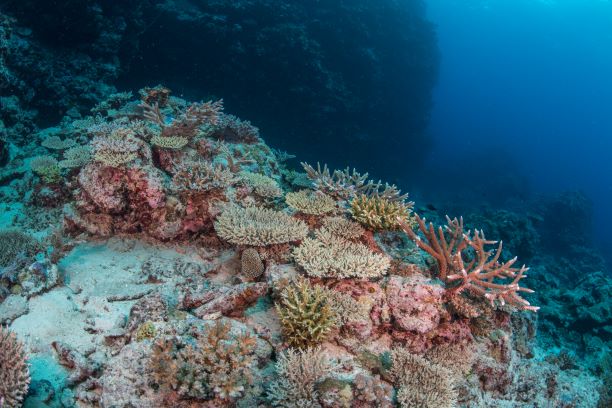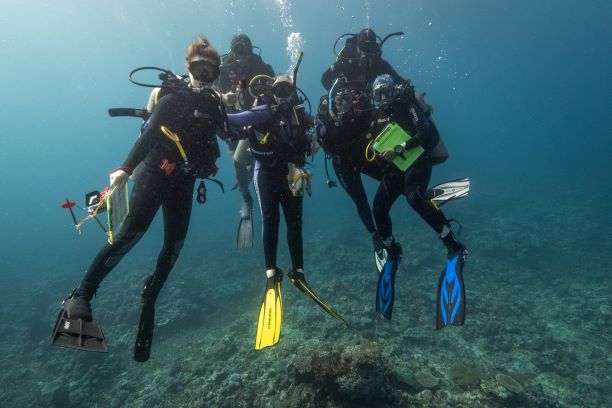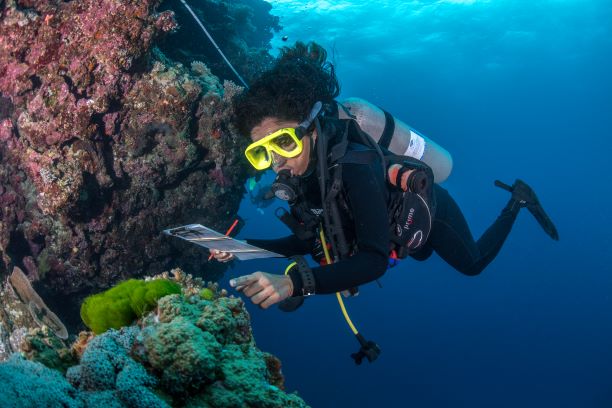A week long mission aboard the Nai’a Fiji Cruises to survey coral reef ecosystems in the Namena Marine Reserve and Vatu-i-Ra Conservation Park.
A recent expedition to Fiji’s largest two community protected areas, Namena Marine Reserve (88 km2) and Vatu-i-Ra Conservation Park (110.5 km2), shows that they are making an incredible recovery from the impact of a tropical cyclone in 2016.
 Coral recruits ©Tom Vierus/WCS
Coral recruits ©Tom Vierus/WCS
The Namena Marine Reserve and Vatu-i-Ra Conservation Park are exceptional places, as they cover full reef ecosystems including small islands, passages, deep reefs and ocean and shallow reefs and slopes. Collectively, both make up almost 80 percent of the area in Fiji protected by local communities in partnership with the tourism industry, and supported by the Wildlife Conservation Society’s Fiji Country Program (WCS Fiji).
On 21 September 2020, a team of 10 Fiji-based marine scientists, led by WCS Fiji, set sail for a five-day expedition to assess the overall health of coral reefs. The team assessed 28 sites in and around the two marine parks, as well as within and adjacent to a number of tabu areas closer to villages that have been established by communities for food security and local livelihoods.
 Team of marine scientists pose for a photo underwater. ©Tom Vierus/WCS
Team of marine scientists pose for a photo underwater. ©Tom Vierus/WCS
The focus of the expedition was to record any changes to the reefs since arrival of Category 5 Tropical Cyclone Winston in February 2016. The cyclone’s 233 kilometer per hour winds and storm-surge induced waves damaged the two reef systems and communities that depend on them for food and livelihoods. The reefs surveyed during the recent 2020 expedition were then compared with rapid assessments that WCS Fiji scientists conducted shortly after the cyclone in 2016.
WCS Fiji Country Program Director and expedition leader Dr. Sangeeta Mangubhai said, “We saw large areas of reef covered by branching corals all roughly the same size and likely to be around four years in age. These new corals are covering surfaces and are providing new habitat for fish.”
Yashika Nand, the WCS Fiji Science Coordinator, explained, “This new coral re-growth shows how quickly many of the reefs have healed since 2016 when we recorded extensive coral breakage, coral abrasion, overturned coral colonies, structural damage to the reef framework and high sedimentation.” Though she noted that other reef areas that were flattened to rubble fields will take much longer to recover.
 WCS marine scientist Yashika Nand surveys the health of corals. ©Tom Vierus/WCS
WCS marine scientist Yashika Nand surveys the health of corals. ©Tom Vierus/WCS
WCS Melanesia Director, Dr. Stacy Jupiter, said, “At a period in history where every day we are seeing bad news in the papers and on television, this is a good news story. Our Fiji reefs are showing that they are stronger than Winston. That said, it is important not to take reef management for granted, even during the COVID-19 pandemic, as such areas need continuing protection to encourage their recovery.”
WCS Fiji has been monitoring the Namena Marine Reserve since 2009 and the Vatu-i-Ra Conservation Park since 2013. The results of the expedition will be shared with the Kubulau Resource Management Committee and the Vatu-i-Ra Management Committee that oversee the management of these two areas. The data from this work will help policy-makers and local resource managers to make informed decisions about the sustainable use and management of coral reefs in Fiji.